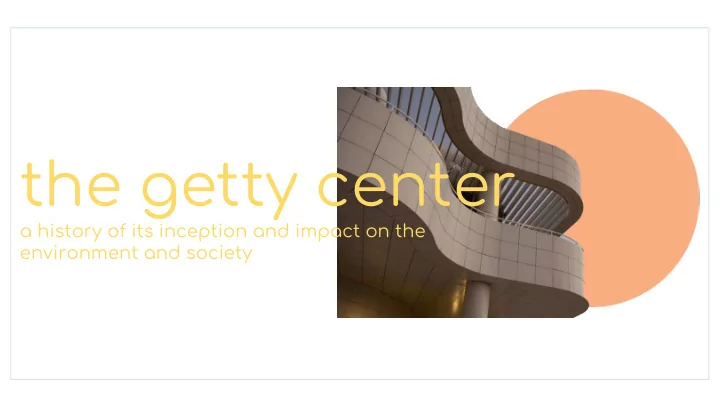

the getty center a history of its inception and impact on the environment and society
history ● This museum is part of the Getty Trust, which was created in 1953 by J. Paul Getty, one of the members of the Getty Family ● The Getty family is one of America’s wealthiest and most well-known, having made their fortune through oil, and through being distantly related to the founder of Gettysburg, Samuel Getty ● The space began out of J. Paul Getty’s home, before expanding to become its own entity after his death ○ J. Paul had a collection of art that he kept in his private space, which was utilized once the Getty expanded to the site it at presently ● J.Paul Getty was known for his avid art-collecting habits, and ultimately wished to make art more accessible for the public eye ● The center was officially opened in December of 1997 and has remained a prominent figure of West Los Angeles since
history (cont’d.) ● TOTAL PRICE: $733 million which includes $449 million for construction, $115 million for the land and site work, $30 million for fixtures and equipment, and $139 million for insurance, engineers' and architects' fees, permits and safety measures ● In terms of the type of art that is mainly housed within the getty, it ranges from painting, sculpture, illuminated manuscripts, photographs, decorative pieces, etc. ● The Getty museum generates 1.8 million visitors annually
architecture ● The architect responsible for the Getty museum is Richard Meier, who designed the property and saw it to fruition ● Meier relied heavily on the grid system, which serves as a sort of boning for the structures within the Getty ● Meier chose warm beige stone to be the main material he designed the Getty to be made of, partially because of the historical significance of building with stone ● It took 16,000 tons of travertine (the kind of stone he used) to make up the Getty ● He also made sure to leave room to accommodate a plethora of windows and skylights so that natural light could be brought in- you’ll notice there isn’t an obnoxious amount of artificial light when walking through ● The Getty is complete with open gardens, and a fountain, with plenty of areas to sit and sunbathe
architecture (cont’d.) ● The garden at the center of the Getty’s courtyard was designed by Robert Irwin ● Planning began in 1992, construction began in 1996, and then the finish occurred in 1997 ● Irwin meant for the garden to be an artistic entity in and of itself, as a type of sculpture ● A main focal point within this garden is the flow of the water, which runs from the museums center out to the circular area within the garden
social impact ● Much of the social impact of the Getty Museum is contingent on the fact that it made art more accessible for the public, which, as stated before, was J. Paul Getty’s ultimate wish ● The rapid growth of the museum and it’s sister branch “The Getty Villa” also changed the landscape of Brentwood and Malibu, as neither historically had booming museum spaces ● Additionally, the Getty almost daily has public events, from concerts to artist talks to special showings, allowing for the public to further engage with the space and build social community around a common interest in art http://neumann.hec.ca/aimac2005/PDF_Text/Scoot_Carol.pdf ○ Within this article, Carol Scott outlines the impact of museums as a whole socially, in building human capital, community capital, and cultural experiences
social impact (cont’d.) Of course, something the Getty Museum Fund had to consider was the impact that the building of the Getty would have on the surrounding homeowners, as the neighborhoods around were already quite established "They have been very good neighbors, and they are trying to address all legitimate concerns. We have a good-spirited relationship that will get us through the humps” - Cosko, building manager Additionally, since the museum is located off of the 405, the congestion surrounding the off-ramp is historically bad, and the museum was apart of an effort in the early 2010’s to expand the 405
environmental impact ● Environmentally, the Getty has proven to be moderately sustainable, utilizing natural light and open fixtures to allow for air flow ● One issue that presented itself during the building of the Museum was that the city mandated that not a single shovel of dirt be removed from the original hillside, and that the displaced soil would need to be moved around the perimeter of the space ● This created massive congestion as 750 workers were present on site, making the space very tight, especially with the challenging topography of a hillside ● The congestion of the off-ramp to the Getty has contributed to the traffic issues that the 405 freeway is notorious for, ultimately raising carbon emissions
Recommend
More recommend